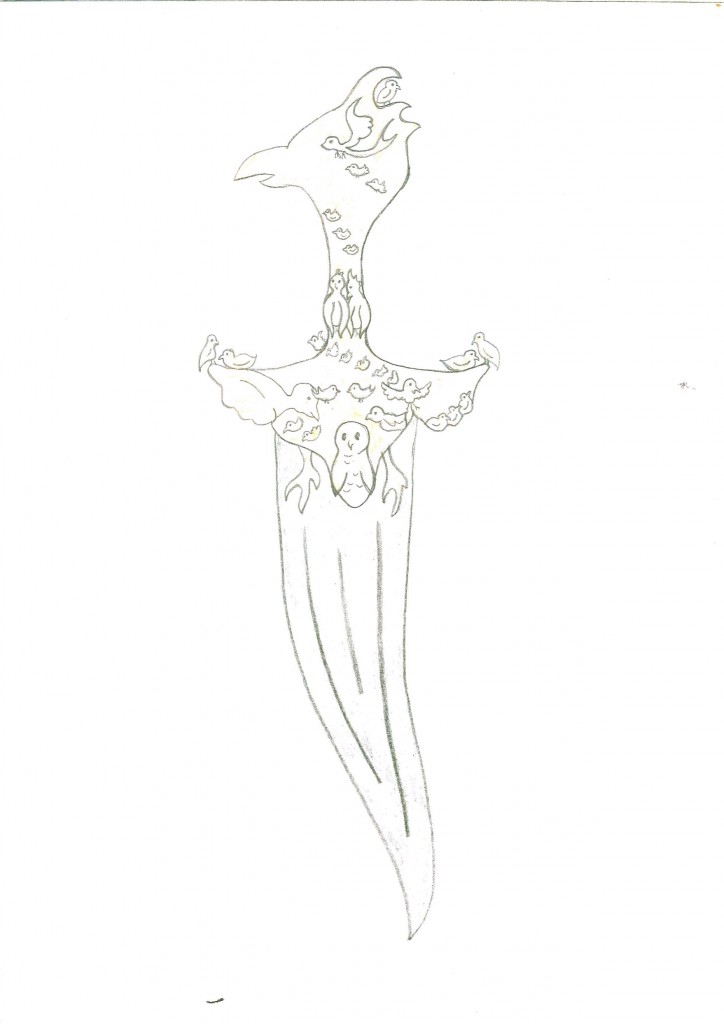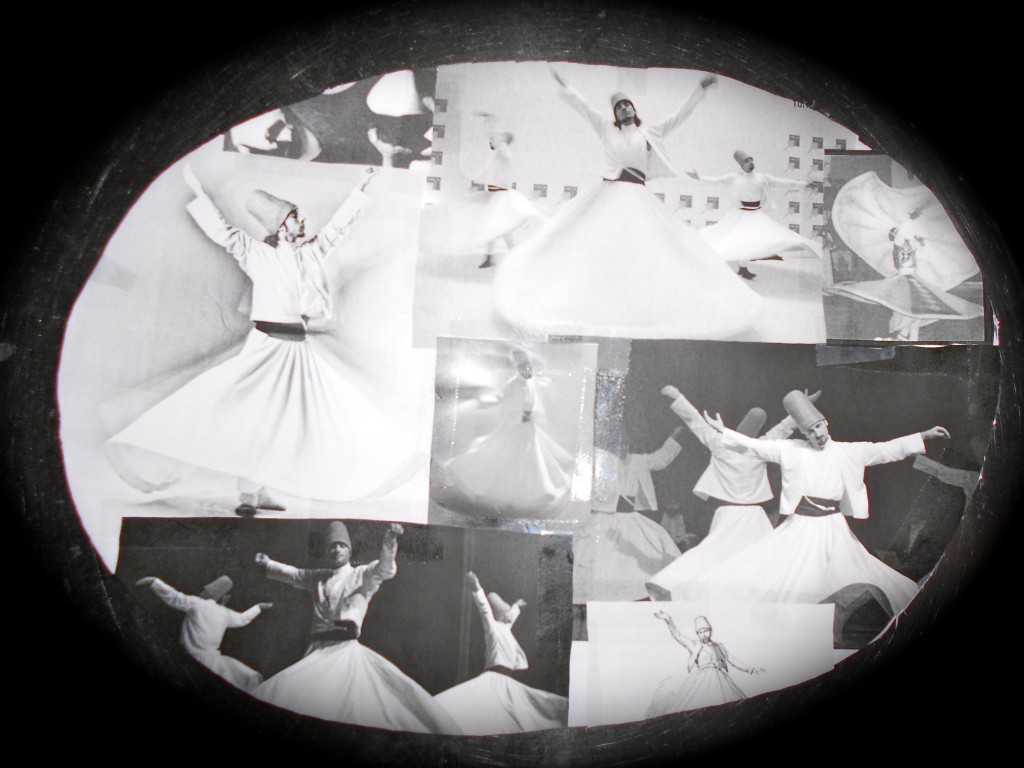Representations and Perceptions of Islam in the West
ø
When I began reviewing the creative responses I had done over the semester, I found that most of them – five out of six to be precise – are more closely related than I had originally thought. Considering that I came to this class with a strong background in cultural studies and, to a lesser and purely “recreational” degree, Middle Eastern politics, it is perhaps not surprising that such themes are reflected in my responses. In addition, my chief concern throughout the class was the very broad question of perception, which is also mirrored in my creative work as well as expressed through the two texts that have become my favorites: Marjane Satrapi’s Persepolis and Rokeya Sakhawat Hussain’s Sultana’s Dream.
My first creative response focuses on the pluralistic and inclusive nature of the terms “islam” and “muslim”, as opposed to their capitalized counterparts which denote an institutionalized religion and are more closely connected with ideology and identity. This especially piqued my interest because I felt that the literal meaning of “islam” and “muslim”, denoting simply “submission to the will of God” and “someone who submits to the will of God”, is rarely noted by non-Muslims and is perhaps overlooked by many Muslims. Interestingly, though the capitalized, or institutionalized, politicized and ideologized, meaning of the terms dominates mainstream perception, the literal meaning better informs an interfaith perspective from which mutual trust and respect can grow. In this respect, I believe that the media in a globalized, post-9/11 world has reinforced the dominance of the capitalized terms by not only simplifying matters to the point of distortion, but also by living by the mantra that “bad news is good news”.
My second response is connected to this predominantly monolithic representation and perception of Islam and epitomizes that there really is no such thing as one Islam. The Isra and Mi‘raj are an integral part of the Islamic tradition, though versions differ concerning, for example, Muhammad’s fainting (or not fainting) at the sight of God, hell, and the Buraq. This, then, emphasizes that even though there is a common denominator for many Islamic traditions, Islam as a religion cannot be easily grasped or reduced to a definite set of dogmata, traditions, and stories. As was demonstrated by the texts we read concerning the Isra and Mi‘raj, Islam is connected to more than just Middle Eastern cultures, another aspect that is often overlooked by mainstream media and society and which further solidifies the perception of Islam as monolithic.
My third response focuses on notions of humanity and dignity, dominant themes in Aminata Sow Fall’s The Beggars’ Strike, which tie into an underlying message that reinforces social justice as the sine qua non of Islam. The central importance of social justice struck me as another vital aspect that is often neglected in the representation of Islam. Not only do representations of Islam post-9/11 promote a simplified and monolithic perception of Islam, but they also construct Islam as the “other” to a supposedly Western and Christian world (in accordance with Said’s Orientalism). Sadly enough, the omission of social justice as a vital element in Islam makes sense here: In order to construct an “other” effectively, it is paramount to boil down a tradition, religion, and people to characteristics that seem not only different but alienating, perhaps even frightening. Hence, the media has emphasized dimensions of Islam that revolve around an essentialist understanding of sharia, especially as it relates to women’s rights and extreme interpretations of jihad. Emphasizing the importance of social justice in Islam, by contrast, would constitute a common ground since – theoretically anyway – the Western tradition also stresses its importance. However, emphasizing the centrality of social justice in Islam would not be overly helpful in constructing an “other”, which is probably why it is rarely stressed in Western politics and media.
Apart from this rather political “othering”, I also felt that there are still ample examples of “othering” the East in the exoticized and eroticized way that were predominant during colonialism, for instance establishing the Mevleviye as tourist attractions. My fourth creative response touches on this, although the work is chiefly concerned with a passage from Carl W. Ernst’s article in his Shambhala Guide to Sufism, which refers to the perception of the Mevleviye in the 19th century. In a way, the Mevleviye are still perceived through a keyhole perspective akin to Jean-Auguste-Dominique Ingres’ in his painting “Le Bain Turc” (1862). A digital camera might have replaced the literal keyhole, but the voyeuristic nature nevertheless remains the same and is now strongly tied to the tourism industry. Again, a complex culture is reduced to a few obvious, superficial aspects (e.g. the particular dress of the Mevleviye), and a deeper understanding of the underlying traditions is usually limited at best.
In my fifth creative response, I strove to capture my struggle and doubts about the claim that the ghazal is a genre that creates “cultural unity” by using themes and metaphors which are universal and understood by virtually everyone. In retrospect, and in taking into account my other creative responses, I continue to object to this supposed “cultural unity”. First of all, “cultural unity” is a rather fickle construct, and I am tempted to dismiss it as impossible in such a broad transnational and translingual context. Secondly, assuming that this “cultural unity” can exist, the ghazal genre would necessarily have to be reduced to aspects that can be understood by everyone regardless of their specific context and backgrounds. This would in turn rob the individual ghazal of the specific background and context of the author, since to claim “cultural unity” the author’s individual idiosyncrasies would have to be either universalized, which seems somewhat difficult to me, or take a backseat to more relatable aspects. What this notion of “cultural unity” comes down to, then, is uncannily close to the simplified and superficial constructions of Islam I discussed earlier – in both cases, something complex is crudely simplified and reduced to unite people.[1]
Unfortunately I ran out of creative responses before we read and discussed Rokeya Sakhawat Hussain’s Sultana’s Dream and Marjane Satrapi’s Persepolis, but they have become personal favorites and offer an interesting addition to my focus on perception in my creative responses, so I have decided to include discussion of them here. In the preface to Rokeya Sakhawat Hussain’s Sultana’s Dream, it is mentioned that her text was usually perceived “as a pleasant dream and not a ‘terrible revenge’ on men for their oppression of women, as her perceptive husband did” (2). This is an interesting statement because it illustrates yet another way in which reduction can be employed to promote a certain perspective. In the case of Sultana’s Dream, this reduction results in a watering down of the text’s strong feminist message, and significantly weakens its transformative potential concerning gender equality. Furthermore, it is noteworthy that as a result of the publication of Sultana’s Dream, Rokeya Sakhawat Hussain was constructed as the “other” by many of her contemporaries who labeled her “a radical misguided by the proselytizing propaganda of Christian missionaries” (53). This, then, emphasizes a significant effect of “othering” that is also applicable to the way in which Islam is represented and perceived, namely that through “othering” an idea, text or religion becomes dismissible and delegitimized.
Marjane Satrapi’s Persepolis stood out to me because I felt that the text succeeded in doing something not easily and not often accomplished, namely building a genuine bridge between Western readers and the Iranian people, even though Satrapi had to mediate between two mutually “othered” cultures. On the one hand, Iran has been dubbed part of Bush’s “Axis of Evil”, and on the other Iran has labeled the United States as the “Big Satan”. Persepolis, as a work that predominantly addresses a Western audience, has to work within the preconditions imposed by a simplified and distorted perception of Iran. A first step in breaking the construction of the “other” is to move from the abstract to actual human beings – something that Persepolis does exceedingly well, in part because it is a graphic novel and can convey human emotions through facial expressions. The importance of the depiction of facial expression cannot be overestimated, since the human face shows the same emotions regardless of the individual’s cultural context and background – or as Marjane Satrapi herself puts it: “And when you draw a situation – someone is scared or angry or happy – it means the same thing in all cultures.” – and creates a sense of human understanding on a basic but nevertheless quintessential level. This recognition of something not all that different is reinforced by the graphic novel’s focus on the protagonist and her immediate family: the reader will inevitably find him- or herself identifying with an aspect of her family’s life and interaction, again emphasizing similarity over difference. In short, Marjane Satrapi succeeds in showing that, ideology, religion, culture and constructed “otherness” aside, there is a lot that all human beings share. Across all national, religious, cultural and linguistic barriers, we all laugh, cry and love in the same way.
Sources:
Marjane Satrapi on drawing a situation: http://www.icelebz.com/quotes/marjane_satrapi/ (accessed 04/29/12).
Sakhawat Hussain, Rokeya. Sultana’s Dream. New York: Feminist Press, 1988. Print.
[1] I am omitting my final creative response here because it does not quite fit in as nicely with the other responses and their relation to perception.





